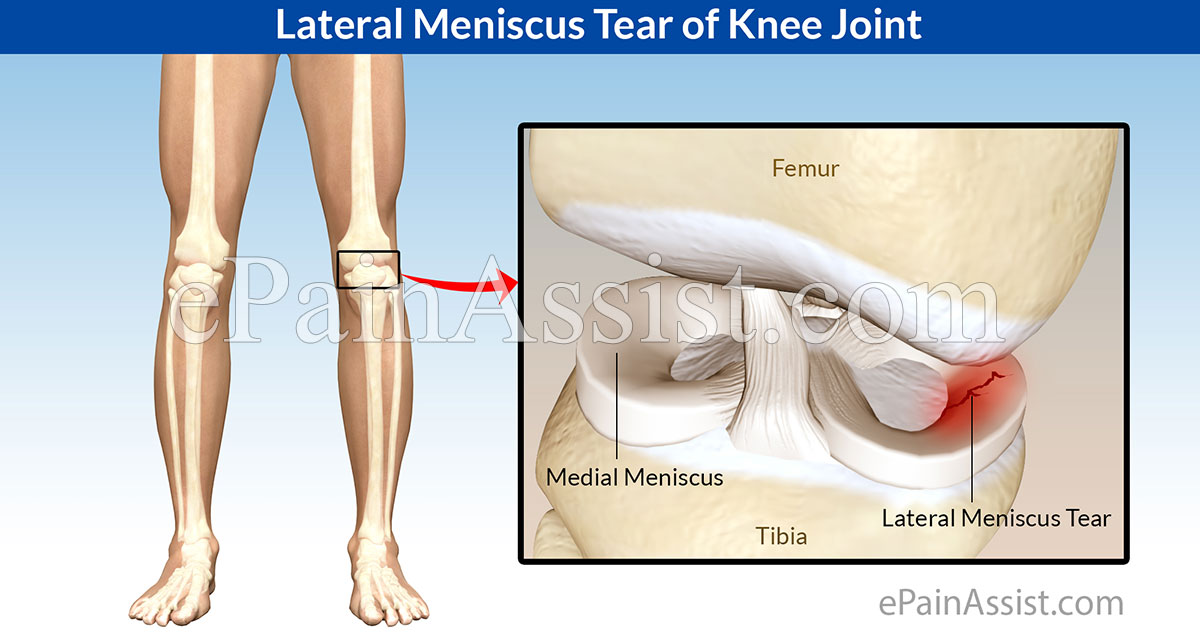The knee is held up and protected by two hemispherical-shaped cartilage menisci present in the knee joint. These cartilages can be damaged or injured as a result of twisting injury or certain other forms of injury.

Lateral Meniscus of Knee Joint
The knee joint is protected by two hemispherical-shaped cartilage known as menisci. Lateral menisci can be damaged or injured as a result of twisting injury or certain other forms of injury. Lateral cartilages of knee joint lies on outer half between femur and tibia bone. The function of the cartilages is to absorb abrupt pressure change resulting in shock. Shock absorption prevents rapid wear and tear by abrupt change of force. Cartilage thus protect the bones and soft tissue within the knee joint.[1]
The injury of lateral menisci is less common than medial menisci or cartilage. Lateral menisci injury is observed following abrupt twist, direct impact and in elderly patient secondary to degenerative knee joint disease.
Types of Meniscal Injury:
- Degenerative Changes of the Cartilage: Due to degeneration, the edges of the menisci become worn out and irregular.
- Longitudinal Tears: The meniscus gets torn along its length.
- Bucket-Handle Tears: This is an extended form of a longitudinal tear. In this tear, a piece of the meniscus gets separated from the tibia and forms a flap that resembles a bucket handle.[2]
Symptoms of Lateral Meniscus Injury
Pain or Tenderness of The Knee Joint-
- Severe pain is localized over lateral area of the joints of the knee.
- Pain intensity is worse in the morning.
- Pain is severe with knee joint movements.
- Pain with flexion of the knee.
- Pain with rotation of the knee.
- Pain when pressing down on the knee (prone position).
Knee Joint Swelling
- Swelling is observed over lateral side of knee joint.
- Swelling is observed after couple of days following the injury.
- Bruises and purple discoloration may be seen following traumatic injury.
Knee Joint Sound
- Audible popping, cracking or clicking sounds heard during knee joint movement.[3]
McMurray’s Test
- Positive.
- Test- The physician will then hold the knee with one hand and the heel with the other. An inward stress is then applied on the knee and the leg is externally rotated with the other hand and the knee is extended. Pain or an audible click during this maneuver signifies a tear of the medial meniscus.[4]
Skin Temperature Over Joint
- Increased temperature of the skin over the joint suggests signs of inflammation.
Restricted Range of Movement
- Range of motion of the knee joint is reduced.
Apley’s Maneuver:
- In case of a suspicion of a meniscal tear, this test is done.
- The patient is positioned on the front with knee flexed.
- The therapist holds the heel and ankle and puts force to the lower part of the leg.
- At the same instance, the lower part of the leg is rotated. If it produces any symptoms of pain or a click, then the test is termed as positive signifying a tear of the meniscus.[5]
Treatment for Lateral Meniscus Tear
Conservative Treatment for Lateral Meniscus Tear
- RICE therapy helps with the swelling.
- Mild amount of exercises is done for maintenance of the quadriceps strength, although if they exacerbate the symptoms then they should not be done.
- Use of a heat retainer.
- In cases of an unstable knee, use of a knee brace or support.
- Glucosamine/joint healing supplement should be taken.
- Consultation with a sports injury specialist.
Medications For Lateral Meniscus Tear
Non Steroidal Anti-Inflammatory Medications (Drugs)- NSAIDs For Lateral Meniscus Tear
- Prescribed for inflammation and pain relief
- Most common NSAIDs prescribed for lateral meniscus tear are Motrin, Celebrex and Daypro
Opioids For Lateral Meniscus Tear-
- Prescribed for pain
- Most common opioid prescribed is hydrocodone or oxycodone.
Muscle Relaxants For Lateral Meniscus Tear-
- Prescribed for muscle spasm and improved joint movement
- Most common muscle relaxant prescribed are skelaxin, robaxin and flexeril
Physical Therapy (PT) For Lateral Meniscus Tear-
Supervised exercise to strengthen muscle and ligament strengths. Other modalities of PT are as follows-
- Electrotherapy
- Ultrasound,
- Laser therapy and
- TENS also help.
Exercises For Lateral Meniscus Tear-
- Mild mobility exercises and stretches should be started to regain full knee range of motion.
- Once the pain has reduced, strengthening exercises for the thigh and calf muscles should be started.
- Proprioception exercises help in increasing the balance and sense of joint positioning. A great product for this is use of a wobble board.[6]
Surgical Treatment for Tear of the Lateral Meniscus (Cartilage):
Arthroscopic Surgical Repair for Lateral Meniscus Tear-
- Surgery is performed to repair meniscal tear using arthroscope.
- Indicated for severe meniscal tears such as a bucket handle tear.
Why Arthroscopic Surgery for Lateral Meniscus Tear?
- The main aim of this surgery is to salvage the meniscal cartilage as much as possible.
- The procedure involves suturing of the torn cartilage.
What is the Outcome of the Arthroscopic Surgery?
- Depends on the severity of the tear.
- Age of the patient and associated degenerative knee joint disease.
- Physical condition of the patient. Patients who are younger and fitter have better results.
Partial Knee Replacement For Lateral Meniscus Tear
- Lateral meniscus is replaced with artificial prosthesis.
- Surgery is less extensive than total knee replacement.
Total Knee Joint Replacement For Lateral Meniscus Tear
- Both the cartilages are replaced with artificial prosthesis.[7]
A rehabilitation program needs to be followed religiously postsurgery comprising of strengthening and balance training so as to hasten the recovery.
- https://www.ncbi.nlm.nih.gov/books/NBK519494/
- https://pubmed.ncbi.nlm.nih.gov/12594567/
- https://medlineplus.gov/ency/patientinstructions/000684.htm
- https://www.ncbi.nlm.nih.gov/pmc/articles/PMC5389077/
- https://www.ncbi.nlm.nih.gov/books/NBK470549/
- https://clinicaltrials.gov/ct2/show/NCT03059004
- https://www.arthritis-health.com/surgery/knee-surgery/types-knee-surgery-arthritis-treatment
